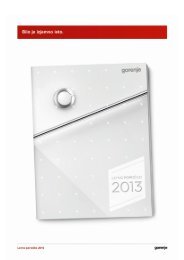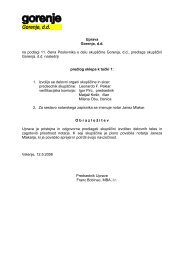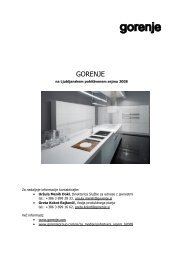Annual Report Gorenje Group 2009
Annual Report Gorenje Group 2009
Annual Report Gorenje Group 2009
You also want an ePaper? Increase the reach of your titles
YUMPU automatically turns print PDFs into web optimized ePapers that Google loves.
Available-for-sale financial assets<br />
Available-for-sale financial assets are non-derivative financial assets that are designated as availablefor-sale<br />
and that are not classified in any of the previous categories. The <strong>Group</strong>'s investments in equity<br />
securities and certain debt securities are classified as available-for-sale financial assets. Subsequent to<br />
initial recognition, they are measured at fair value, including changes therein. Impairment losses (see<br />
note 3(i)(i)) and foreign currency differences on available-for-sale equity instruments (see note 3(b)(i))<br />
are recognised in profit or loss and presented within equity in the fair value reserve. When an<br />
investment is derecognised, the cumulative gain or loss in other comprehensive income is transferred<br />
to profit or loss.<br />
(i) Non-derivative financial liabilities<br />
The <strong>Group</strong> initially recognises debt securities issued and subordinated liabilities on the date that they<br />
are originated. All other financial liabilities (including liabilities designated at fair value through profit or<br />
loss) are recognised initially on the trade date at which the <strong>Group</strong> becomes a party to the contractual<br />
provisions of the instrument. The <strong>Group</strong> derecognises a financial liability when its contractual<br />
obligations are discharged or cancelled or expire. Financial assets and liabilities are offset and the net<br />
amount presented in the statement of financial position when, and only when, the <strong>Group</strong> has a legal<br />
right to offset the amounts and intends either to settle on a net basis or to realise the asset and settle<br />
the liability simultaneously. The <strong>Group</strong> has the following non-derivative financial liabilities: loans and<br />
borrowings, bank overdrafts, trade and other payables. Such financial liabilities are recognised initially<br />
at fair value plus any directly attributable transaction costs. Subsequent to initial recognition these<br />
financial liabilities are measured at amortised cost using the effective interest method.<br />
(iii) Derivative financial instruments, including hedge accounting<br />
The <strong>Group</strong> holds derivative financial instruments to hedge its foreign currency and interest rate risk<br />
exposures. Embedded derivatives are separated from the host contract and accounted for separately if<br />
the economic characteristics and risks of the host contract and the embedded derivative are not closely<br />
related, a separate instrument with the same terms as the embedded derivative would meet the<br />
definition of a derivative, and the combined instrument is not measured at fair value through profit or<br />
loss.<br />
On initial designation of the hedge, the <strong>Group</strong> formally documents the relationship between the<br />
hedging instrument(s) and hedged item(s), including the risk management objectives and strategy in<br />
undertaking the hedge transaction, together with the methods that will be used to assess the<br />
effectiveness of the hedging relationship. The <strong>Group</strong> makes an assessment, both at the inception of<br />
the hedge relationship as well as on an ongoing basis, whether the hedging instruments are expected<br />
to be "highly effective" in offsetting the changes in the fair value or cash flows of the respective hedged<br />
items during the period for which the hedge is designated, and whether the actual results of each<br />
hedge are within a range of 80-125 percent. For a cash flow hedge of a forecast transaction, the<br />
transaction should be highly probable to occur and should present an exposure to variations in cash<br />
flows that could ultimately affect reported net income.<br />
Derivatives are recognised initially at fair value; attributable transaction costs are recognised in profit or<br />
loss as incurred. Subsequent to initial recognition, derivatives are measured at fair value, and changes<br />
therein are accounted for as described below.<br />
Cash flow hedges<br />
When a derivative is designated as the hedging instrument in a hedge of the variability in cash flows<br />
attributable to a particular risk associated with a recognised asset or liability or a highly probable<br />
forecast transaction that could affect profit or loss, the effective portion of changes in the fair value of<br />
the derivative is recognised in other comprehensive income and presented in the hedging reserve in<br />
equity. The amount recognised in other comprehensive income is removed and included in profit or<br />
loss in the same period as the hedged cash flows affect profit or loss under the same line item in the<br />
statement of comprehensive income as the hedged item. Any ineffective portion of changes in the fair<br />
101<br />
<strong>Annual</strong> <strong>Report</strong> <strong>Gorenje</strong> <strong>Group</strong> <strong>2009</strong>

















